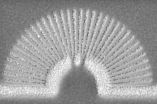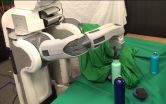This Slinky lookalike 'hyperlens' helps us see tiny objects
The photonics advancement could improve early cancer detection, nanoelectronics manufacturing and scientists' ability to observe single molecules
2015-05-22
(Press-News.org) BUFFALO, N.Y. -- It looks like a Slinky suspended in motion.
Yet this photonics advancement -- called a metamaterial hyperlens -- doesn't climb down stairs.
Instead, it improves our ability to see tiny objects.
Described in a research paper published today by the journal Nature Communications, the hyperlens may someday help detect some of the most lethal forms of cancer.
It could also lead to advancements in nanoelectronic manufacturing and boost scientists' ability to examine single molecules -- a development with implications in physics, chemistry, biology and other fields.
"There is a great need in health care, nanotechnology and other areas to improve our ability to see tiny objects that elude even the most powerful optical systems. The hyperlens we are developing is, potentially, a giant step toward solving this problem," says Natalia Litchinitser, PhD, professor of electrical engineering at the University at Buffalo and the paper's lead author.
Co-authors are Jingbo Sun, PhD, assistant research professor of electrical engineering at UB, and Mikhail I. Shalaev, a PhD candidate in Litchintser's lab.
Conventional optical systems, such as microscopes and cameras, are limited by diffraction, a phenomena in which light bends as it passes around an edge or through a slit. An example of this are the closely spaced tracks of a DVD, which form a rainbow pattern when looking at the disk.
A downloadable image of the metamaterial hyperlens is available here: http://www.buffalo.edu/news/releases/2015/05/039.html.
Diffraction sets a fundamental limit to the resolution of optical systems.
Scientists are working to solve diffraction with metamaterials, which are materials engineered to have properties not yet discovered in nature.
Typically, the materials are arranged in repetitive patterns, often smaller in scale than the wavelengths of the phenomena they influence.
Metamaterial hyperlenses overcome the diffraction limit by transforming decaying evanescent waves into propagating waves. Once converted, the former decaying waves, which were commonly lost in conventional imaging, can be collected and transmitted using standard optical components.
Some of the first metamaterial hyperlenses consisted of tiny concentric rings of silver and dielectric (an insulating material). However, this design only works within a narrow range of wavelengths and it suffers from large losses of resonance.
Instead of concentric rings, UB researchers formed tiny slivers of gold and PMMA (a transparent thermoplastic) into a radial shape. The design of this metamaterial hyperlens, which looks like a Slinky suspended in motion, overcomes the diffraction limit in visible frequency range. Moreover, it can be integrated with an optical waveguide, opening the door to hyperlens-based medical endoscopes.
More studies are required, but such a tool could improve doctors' ability to detect some of the most lethal forms of cancer, such as ovarian cancer.
For example, today's high-resolution endoscopes can resolve objects to about 10,000 nanometers. The hyperlens could improve that to at least 250 nanometers or better. This is important because the earlier doctors are able to discover hard-to-find cancers, the more success they have treating the disease.
Another potential application centers on optical nanolithography, the process of passing light through a mask to a pattern on polymer film. Continuous improvement in this field is essential to building the next generation of optoelectronic devices, data storage drives, sensors and other gadgets.
The hyperlens also show promise in sequencing single molecules, a potential advancement with broad implications in numerous fields of research including physics, chemistry and biology.
INFORMATION:
The research was supported by grants from the U.S. Army Research Office and the National Science Foundation.
[Attachments] See images for this press release:

ELSE PRESS RELEASES FROM THIS DATE:
2015-05-22
WASHINGTON, D.C. -- Disaster investigators and emergency personnel may find themselves better able to assess and respond to terrorist attacks and industrial accidents with the aid of a new computational tool that determines the energy from explosions near the Earth's surface. As a first test of the new approach, its developers have analyzed a deadly explosion which reportedly killed dozens of regime soldiers in the Syrian civil war.
Computing the energy yield of an explosion just below, at, or above the ground poses difficult challenges, while deep-underground blasts ...
2015-05-22
New York, NY -- May 22, 2015 -- Working with researchers at Zhejiang University in China, Changxi Zheng, assistant professor of computer science at Columbia Engineering, has developed a technique that enables hydrographic printing, a widely used industrial method for transferring color inks on a thin film to the surface of manufactured 3D objects, to color these surfaces with the most precise alignment ever attained. Using a new computational method they developed to simulate the printing process, Zheng and his team have designed a model that predicts color film distortion ...
2015-05-22
(NEW YORK - May 22) - By comparing flu viruses to the virus that causes measles, researchers fine-tuned a tool that may enable faster vaccine design, according to a study led by Mount Sinai researchers and published online this week in the journal Cell Reports.
The study results revolve around viruses, which are designed perfectly by evolution to invade human cells, inject viral genes and use human genetic machinery to make copies of them. In an endless back and forth, human immune cells have evolved to recognize and attack viral surface proteins, and viruses to constantly ...
2015-05-22
(PARIS, FRANCE) Technique, talk, and talent were three buzzwords at the 2015 EuroPCR congress. As in years past, the conference featured a mix of breaking news, live case demonstrations, oral and poster sessions, debates, and tips-and-tricks tutorials. New study data have been increasingly showcased at EuroPCR and this year's meeting featured over 70 new abstract sessions throughout the four-day meeting, across five interventional tracks.
One of the focus topics at this year's meeting was a spate of recent trials showing a benefit for mechanical thrombectomy in acute ...
2015-05-22
URBANA, Ill. - The widespread evolution of herbicide-resistant weeds is costing farmers, especially through decreases in productivity and profitability. Although researchers and industry personnel have made recommendations to slow this evolution, an understanding of the patterns and causes of the resistance has been limited.
Diversifying the herbicide mechanisms of action (MOAs) has been recommended to stop the spread of herbicide-resistant weeds. MOAs refer to the biochemical interaction that affects or disrupts the target site in the weed. Two common methods of diversifying ...
2015-05-22
The first definitive summary of the best and safest blood pressure lowering treatments for kidney disease and diabetes patients has been compiled by New Zealand doctor and researcher Associate Professor Suetonia Palmer.
The international relevance of her work for doctors, patients and those who decide which drugs to fund has been demonstrated by the prestigious Lancet medical journal publishing an article on her study in its latest edition.
The University of Otago, Christchurch, researcher together with a global team used innovative statistical analysis to compare hundreds ...
2015-05-22
Berkeley -- Researchers at the University of California, Berkeley, have developed algorithms that enable robots to learn motor tasks through trial and error using a process that more closely approximates the way humans learn, marking a major milestone in the field of artificial intelligence.
They demonstrated their technique, a type of reinforcement learning, by having a robot complete various tasks -- putting a clothes hanger on a rack, assembling a toy plane, screwing a cap on a water bottle, and more -- without pre-programmed details about its surroundings.
"What ...
2015-05-22
WASHINGTON, D.C., May 22, 2015 -- Play a flute in Carnegie Hall, and the tone will resonate and fill the space. Play that same flute in the Grand Canyon, and the sound waves will crash against the rock walls, folding back in on each other in sonic chaos. The disparity in acoustics is clear - to the modern listener, the instrument belongs in an auditorium.
"Distinct echoes would be totally unforgivable in today's performance spaces," says Steven J. Waller, an archaeo-acoustician who has studied prehistoric rock art and the acoustics of ancient performance spaces. "But, ...
2015-05-22
WASHINGTON, D.C., May 22, 2015 -- The room is loud with chatter. Glasses clink. Soft music, perhaps light jazz or strings, fills the air. Amidst all of these background sounds, it can be difficult to understand what an adjacent person is saying. A depressed individual, brought to this cocktail party by a well-meaning friend, can slide further into himself, his inability to hear and communicate compounding his sense of isolation.
"A lot of research has suggested that these people with elevated depression symptoms have a bias towards negative perception of information ...
2015-05-22
Why do good people do bad things? It's a question that has been pondered for centuries, and new research published by the Society for Personality and Social Psychology may offer some insights about when people succumb to versus resist ethical temptations.
"People often think that bad people do bad things and good people do good things, and that unethical behavior just comes down to character," says lead research author Oliver Sheldon, PhD. "But most people behave dishonestly sometimes, and frequently, this may have more to do with the situation and how people ...
LAST 30 PRESS RELEASES:
[Press-News.org] This Slinky lookalike 'hyperlens' helps us see tiny objects
The photonics advancement could improve early cancer detection, nanoelectronics manufacturing and scientists' ability to observe single molecules


